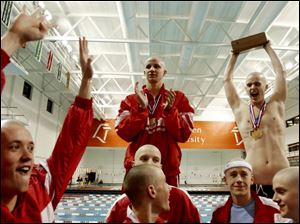This is a scatterplot of athletes' win percentage in Majors vs. win percentage at other non-Major tournaments.
- I have plotted male golfers (Tiger Woods pre-scandal, current Tiger Woods, Phil Mickelson, Jack Nicklaus) and female golfers (Yani Tseng, Annika Sorenstam) in black and male tennis players (Pete Sampras, Roger Federer, Rafael Nadal, Novak Djokovic) and female tennis players (Venus and Serena Williams, Martina Navratilova, Chris Evert, Steffi Graf) in red.
- Annika Sorenstam and Novak Djokovic are tough to read due to overplotting in the middle of the plot.
- The solid line represents the 45-degree line (y = x) and the dashed line is the least squares regression line.
Here are the most interesting features in this graph (to me, at least):
- Phil Michelson does not win tournaments (Majors and non-Majors) as frequently as the other athletes.
- Graf won much more often than anyone else - over 50% of non-Major tournaments and 40% of Major tournaments. From this view, it seems that Graf is clearly the best female tennis player, with Evert and Navratilova not too far behind.
- Athletes close to the solid line win Majors at the same frequency as non-Majors. This seems to represent the set of athletes who are not intimidated by the pressure at the Majors.
- Yani Tseng is the only athlete much farther above the line - she seems to over-preform at the Majors. It is still very early in her career, so I would not be surprised if she moves closer to the diagonal line as her career progresses.
- The athletes below the line tend to under-perform at the Majors compared to other tournaments. But this set contains some of the best athletes ever, so this is not quite a fair assessment (Venus has 7 majors and Evert and Navratilova 18 each). Maybe it is more fair to say that they over-perform at non-Majors.
- Federer and Nadal have very similar winning percentages. Since Federer is 5 years older than Nadal, it will be interesting to see if Nadal can keep this same pace for the next 5 years to catch up to Federer in terms of tournaments won.



